Featured snippets are an important part of SEO.
They can increase your website’s visibility and help you attract more traffic.
So, do you want to earn a position zero?
This post got you covered.
Read what featured snippets are, why they are important, how to get them, and the best practices to optimize your content for them.
What Are Featured Snippets?
Featured snippets are special boxes of text that are displayed on top of search results to give a quick answer to a user’s query:

They were first introduced in 2014, and they have been growing in popularity ever since.
A featured snippet contains a summary of the answer, which is pulled from your website’s content.
It is displayed above the organic search results, and it can be a great way to increase your online visibility.
✅ It is often called position zero because it appears before the first position on the search engine results page.
Why Featured Snippets Are Important for SEO?
Like other SERP features, also the featured snippets are important for SEO because they can help you attract more traffic to your website.
They are also a great way to improve your click-through rate (CTR), which is a key metric that is used to measure the success of your SEO efforts.
They can also help you rank higher in the search results, which can lead to more traffic and higher CTRs. Plus, they can help you build brand awareness and credibility.
When your website is featured in position zero, it helps you build trust with users and shows that your content is relevant and trustworthy. This can lead to more potential sales and conversions for your business.
In fact, a study by Ahrefs shows that featured snippets steal a good portion of traffic from the top position in the organic results and get approximately 8% of all clicks:
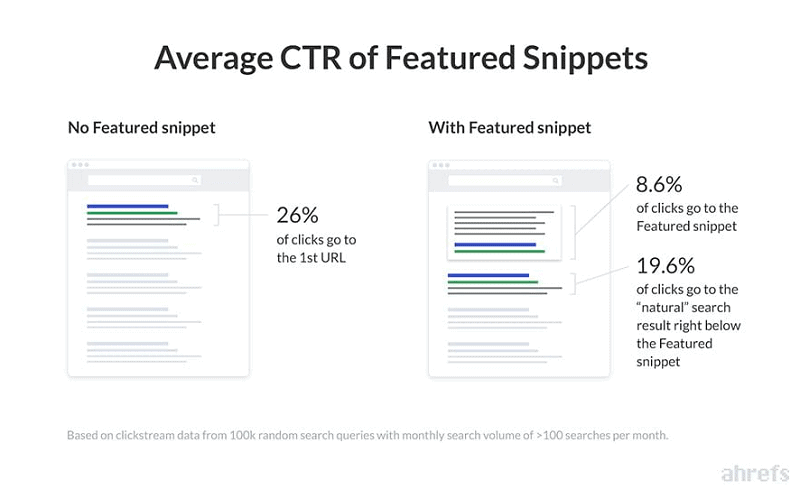
This means that if you can get your content featured, you can improve your organic click-through rate and your chances of being included in the voice search results too.
Different Types of Featured Snippets
Featured snippets are not always displayed the same way. They are different, depending on the kind of information the user is searching for.
If you can understand what kind of snippet best matches your topic, you can optimize your content around it to get the best chance of being displayed on Google position zero.
With this in mind, let’s analyze the four types:
Paragraph
This is the most common one, and it contains a summary of the answer in a paragraph format.
Google often uses this kind of snippet to answer “what” questions.
For example, “What is Google position zero“?
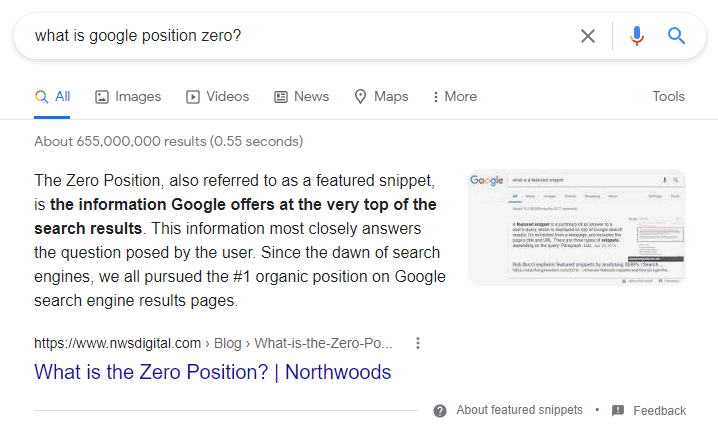
List
This one contains a list of items, such as a list of steps or a list of ingredients.
For example, see what it looks like the result for the query “top blogging sites“:

Table
This type contains a table with information, such as data or prices.
For example, see the result for the query “revenue of largest companies in the world“:
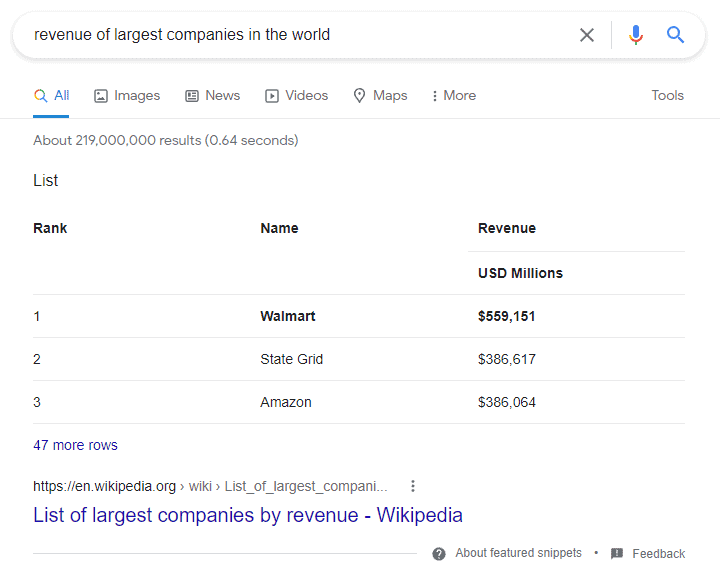
Video
This type of snippet contains a video that is relevant to the user’s query.
Google will often use it to answer “how-to” questions.
For example, “How to knot a tie“:
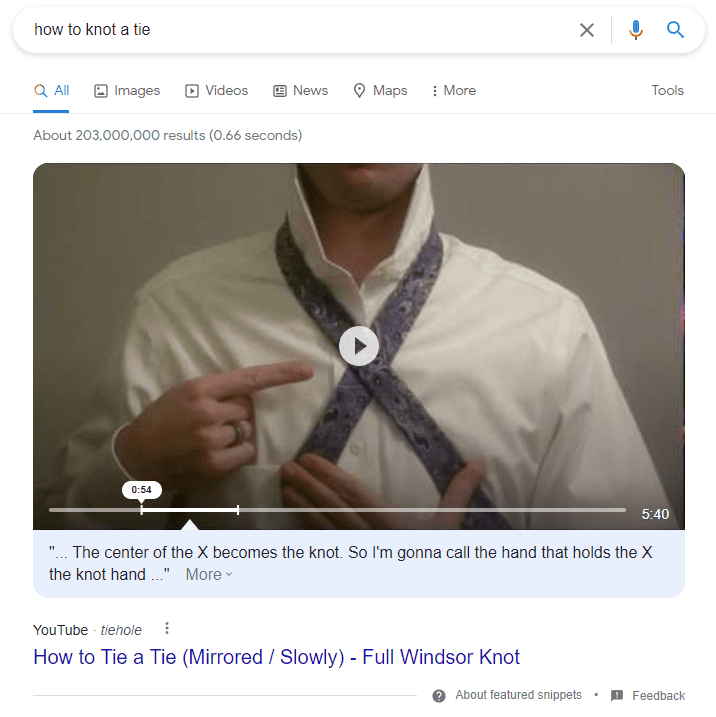
Featured Snippets Statistics
Semrush studied 1 million random SERPs that contain featured snippets and analyzed the data to find insights that will help every content creator be placed on Google position zero.
Here are the key takeaways of the study:
- 19% of SERPs have featured snippets
- 7,3% of SERPs have double-featured snippets
- 50%+ of a mobile screen is covered with a featured snippet

The four types are present in the organic results, based on these numbers:
- Paragraph 70% (with an average of 49 words and 249 characters)
- List 19,1% (with an average of 6 items and 44 words)
- Table 6,3% (with an average of 5 rows and 2 columns)
- Video 4,6% (with an average of 6 minutes and 25 seconds)

The industries that have the biggest number of featured snippets are:
- Travel (in 62% of cases)
- Computer and electronics (in 62% of cases)
- Art and entertainment (in 59% of cases)
- Science (in 54% of cases)

Some additional, interesting patterns in the data analyzed by Semrush:
- Question words: 77,6% of questions starting with “why” have a featured snippet
- Date: 70% of articles in featured snippets were published no later than 2-3 years ago
- URLs: in 80,4% of cases featured snippets contain URLs with 1-3 subfolders

The best-performing content that earned position zero has these characteristics:
- 98% HTTPS
- 1100+ words (5 minutes read)
- 66% of articles use structured data
- 14.5 average number of headlines
- 8 images with alt tags

How to Optimize Your Content For Featured Snippets
While Semrush’s study reports that around 19% of all search queries include a featured snippet, Ahrefs point of view is only 12.3%.
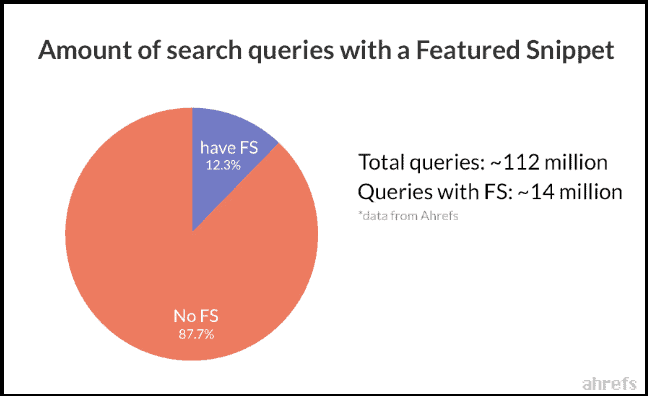
As you can see, both percentages are pretty low, which means position zero does not appear much in SERPs.
💡 So, how can you increase the chance of earning one?
Google is constantly evaluating content on the web to deliver the best result to users’ queries.
For example, a list snippet can be replaced by a video snippet, if Google finds a video that better answers that query.
And what does it mean for you?
To optimize your content for SEO, you need to focus on delivering quality, relevance, and added value.
You can do this by including the right keywords and making sure that it is relevant to the user’s query.
Here are some tips that can help you with that:
-
- Target long-tail keywords in the form of questions
- Answer questions in your content
- Use a table structure
- Work on your EEAT
- Optimize Your Content for Users
- Use Keyword-Rich Titles and Descriptions
- Optimize Your Website for Mobile
- Use Short, Simple Sentences and Paragraphs
- Use Bullet Points and Lists
- Highlight Important Information with Bold Or Italic Text
- Use Images and Videos
Target Long-Tail Keywords in the Form of Questions
One of the best ways to optimize your content is to target long-tail keywords in the form of questions.
So, aim to create evergreen content that answers questions such as:
- What is …?
- Why is …?
- How to …?
👉 Read how I earned position zero for this sweet long-tail keyword.
Answer Questions in Your Content
Another thing you can do is answer questions directly in your content.
For instance, this can be accomplished by including a section in your article that is specifically dedicated to FAQs.
You can also use headings and subheadings to structure your content in a way that makes it easy for users to find the answers they are looking for.
Here is an example of how you can answer questions:
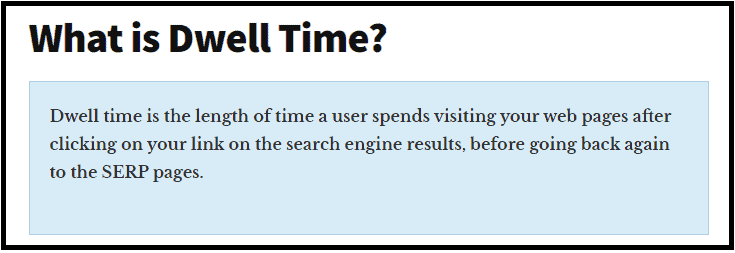
Use a Table Structure
This can be helpful if you are trying to target a featured snippet that contains a list or table.
By using a table structure (<table>), you can make it easier for Google to find and understand the information in your content.
You can also use this format to highlight key information and make it easy for users to scan your page.
Work on Your E-E-A-T
Did you know that more than 99% of featured snippets on Google are already ranked between positions 1 to 10?
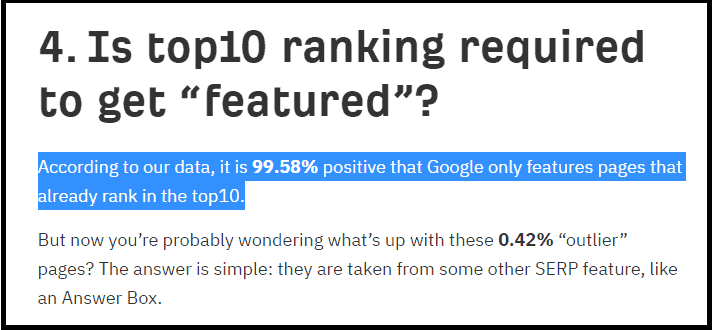
This SEO statistic comes from an Ahrefs study, which proves that you need to take your E-E-A-T seriously.
So, what is it, exactly?
E-E-A-T stands for Experience, Expertise, Authoritativeness, and Trust.
And this is something that Google (and its raters) take into account when accessing sites in search results.
But, how can you improve it?
Backlinks are a good way to signal to Google that your content is authoritative and trustworthy (read these 100 link-building strategies you can use to improve your organic rankings).
Other than that, you can enhance your website’s E-E-A-T by:
- Creating high-quality resources (avoiding duplicate content)
- Including citations and references
- Focusing on semantic SEO and LSI keywords
- Ensuring your website is safe and secure (verify HTTP status code)
- Making sure your content is accurate and up-to-date (if not, be sure to update it)
- Building your online authority by sharing your knowledge around the web (with guest posts, for example)
Optimize Your Content for Users
Improving the user experience is an essential part of SEO (together with working on your core web vitals).
💡 So, consider these suggestions to help you increase the time on your site and improve your bounce rate:
- Use keyword-rich titles and descriptions
- Optimize your website for mobile
- Use short, simple sentences and paragraphs
- Use bullet points and lists
- Highlight important information with bold or italic text
- Use images and videos
Use Keyword-Rich Titles and Descriptions
Your title and meta description are important elements of your content that can help you rank better in the search results.
Make sure to include relevant keywords in them to improve your chances of being featured in position zero.
Optimize Your Website for Mobile
Google is now using mobile-first indexing, which means that it is using the mobile version of your website to index and rank your content.
Remember that your website should load fast and be optimized for mobile devices to improve your chances of getting a featured snippet.
You can use the tool by Google to check if your pages are mobile-friendly, or verify in Search Console:
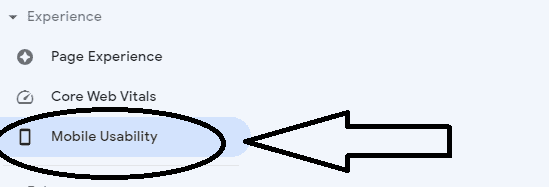
Use Short, Simple Sentences and Paragraphs
When creating your content, write short, simple sentences and paragraphs.
✅ Leverage the bucket brigade technique by using a short sentence followed by a longer one.
This will help keep your readers engaged and make your pages easier to read.
Plus, you will help Google understand your content to match it with user queries.
Use Bullet Points and Lists
Bullet points and lists are easy to read and understand, so they are a great way to organize your content.
Google is more likely to feature content that is organized in this way.
Highlight Important Information with Bold Or Italic Text
If you want to highlight important information in your content, use bold or italic text.
It will help users to identify the most important parts of your content.
Use Images and Videos
SEO-friendly images and videos can help to break up your text and make your content more visually appealing.
They can also help Google to understand your content better.
Bonus Tip
Finally, you can also check the organic results for certain queries and see if there’s already one of the four types of snippets, so you know that Google already wants to display a position zero for those keywords.
💡 If there is, then you can try to optimize your content for it to steal the featured snippet.
Featured Snippets FAQs
Q: How do I get a featured snippet?
A: You need to provide content that answers user queries better than other pages already available on the internet. Focus on creating something that delivers value!
Q: Is the featured snippet a rich result?
A: Yes, the featured snippet is a type of rich result. Rich results appear on search engine results pages (SERPs) and include extra information such as images, videos, reviews, and more.
Q: Does being featured in a snippet help with SEO?
A: Yes, being featured in a snippet can help with SEO. When Google displays your content as a snippet, it shows that your page is relevant and provides valuable information. This can help to increase visibility in the SERPs and likely improve your organic traffic.
Q: Is being featured in a snippet guaranteed?
A: No, it is not guaranteed that your page will be featured in a snippet. Google uses algorithms to determine which pages to choose. You can take the steps mentioned above and hopefully earn a position zero.
Before You Go
Thanks for reading so far.
At this time, you should have learned about featured snippets and how they are a great way to attract more traffic and improve your online visibility.
But what about rich snippets? Do you know anything about them?
And the SERP features? Are you aware of all the Google SERP elements?
Now, it’s over to you.
How many position zeros does your content have?
Let me know in the comments below!

hello Erik, You nailed it very well.
The visual explanation is very interesting. Thank you for that.
Every blogger tries to rank their blog in featured snippets. For all those this article go to resource.
Keep bring such awesome content on this blog.
Hello Venkat,
I think visuals help a lot in explaining the concepts.
I try to add relevant and useful media to give readers additional information.
Good luck in earning some featured snippets with your content! 😉
Thanks Erik for the great effort you put into making awesome informative articles especially for beginners like myself.
You’re welcome, Winfred.
Erik this is a helpful guide bro. Landing a few featured snippets can boost your blogging credibility powerfully. I love how Google lays these out; the style seems appealing to me, goading me to click.
Thanks for the awesome feedback, my friend.
I’m sure your content landed on several sweet featured snippet spots! 🙂